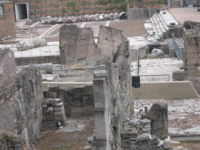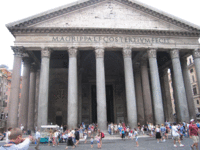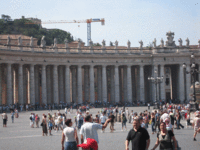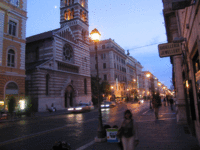I arrived in Rome Tuesday afternoon and in the train station was personally warned about pick pockets. (I later received a second personal heads-up.) So, I thought of Tom Ridge, raised my security alert to Orange and practiced “increased vigilance.”
I took the underground Metro to my host Nicola’s flat, picked up the key from the janitor, and settled in. He wasn’t coming back until late the next night, so I had the place to myself. It’s nestled in a nice northern residential neighborhood, free of tourists, close to the metro and buses, and right across the street from a pizzeria.
The package I mailed to myself from San Francisco was waiting and I anxiously opened it to find the several books I sent, including a Rome guidebook, and about a dozen Cliff Bars. I spent the rest of the afternoon trying to nap and reading about Rome. I allocated more time to Rome than any other city — 5 nights — because I had heard so many good things. So I felt no need to pack each day with activities.
The next morning I set off for St. Peter’s Square. The Big Man — aka Benedict, aka The Pope — was making his weekly address on this Wednesday morning from his summer house away from Rome. They were still broadcasting it in the main St. Peter’s square. The tourist scene in Rome is so thick that once you find the general location of a place you just follow the crowds. I walked along leisurely, still recovering from my frantic last day in Florence, and enjoying all the nuns from all over the world walking hurriedly into the square.
St. Peter’s square is amazing! Massive TV screens projected Pope Benedict’s address. The whole atmosphere is architecturally awe inspiring and spiritually very “alive.” I could tell to even be in the square was an important religious experience. I listened to Benedict speak in several different languages and different sections of the crowd erupting at hearing their native tongue.
 From there I wandered over to St. Peter’s Basicilia / Sistine Chapel and the Vatican Museum. A good 1.5 hour queue to get in. When I finally got in, I took my fine time. I checked out paintings and frescoes and statues. I took breaks on a chair and reviewed my guidebook for some historical background. There’s one huge arched hallway filled with gold and frescoes — incredible. The Sistine Chapel itself finally came and was kind of overwhelming. No pictures allowed, but to see frescoes like THe Last Supper up close and personal was awesome.
From there I wandered over to St. Peter’s Basicilia / Sistine Chapel and the Vatican Museum. A good 1.5 hour queue to get in. When I finally got in, I took my fine time. I checked out paintings and frescoes and statues. I took breaks on a chair and reviewed my guidebook for some historical background. There’s one huge arched hallway filled with gold and frescoes — incredible. The Sistine Chapel itself finally came and was kind of overwhelming. No pictures allowed, but to see frescoes like THe Last Supper up close and personal was awesome.
Exhausted from the several hour visit to the Vatican (a sovereign state with their own currency), I returned to the flat, hung out, and then headed down to the train station for some admittedly expensive wi-fi. I had a dinner at a cheap restaurant and then walked casually along the blocks near the main train station. This is a great after dinner walk. Few tourists, sun hitting tops of buildings, a warm breeze. I got so caught up in the beauty of my walk that 9 PM passed me and as I learned later the Metro line I take closes at 9 PM for repairs. I was screwed. It took me 2.5 hours to get home as I hopped on different buses and trams and each driver told me something different. Disaster.
Day 3 I focused on the Roman Forum, Coliseum, and Pantheon. The Roman Forum deserves a good hour of walking around. A guided tour is overkill, I think. Simply gaping at the relics and trying to imagine Roman business being conducted is good enough. Of course, it’s hard to stay too long at the Forum because you see the Coliseum in the distance. Seeing the Coliseum from afar was like looking at a guidebook. It looked just like it does in the pictures. Before entering the lengthy queue to get in, I bought a sandwich at a cheap stand set up outside. In front of me were some black American guys speaking ghetto English (which i haven’t heard in awhile) to Italians who didn’t seem to understand a word: “You not hearing me. Gimme my money back. Give me my fucking euro back. You aint givin’ me the right size ice cream.” Indeed.
The Coliseum lived up to its billing as the most important tourist attraction in Rome. On this stop I regretted not doing a tour — I think it’s chock full of interesting details which would have been useful. I also haven’t seen “The Gladiator” so I didn’t have my Russell Crowe imagery top of mind. Nonetheless, the whole set up can’t be described in words, so I leave a photo and a request that you, too, visit it.
The Pantheon isn’t too far away and equally deserving of aesthetic and architectural praise. It made me think fondly about my 5th grade humanities assignment to build a replica of a pantheon using white cardboard. Seeing it up close and personal, it’s hard to get your head around a few questions: how did they find single pieces of stone that served as the doric columns? How can there be no reinforced concrete?

Two full days in Rome knocked off the key attractions, leaving me with two more days to check out secondary sights and try to catch up on reading.

Ben Casnocha is the author of the bestselling business book
‘My Start-Up Life: What a (Very) Young CEO Learned on His Journey Through Silicon Valley”, which the New York Times called “precocious, informative, and entertaining.” He founded Comcate, Inc., an e-government software company, at age 14. Ben’s work has been featured in dozens of international media including CNN, USA Today, CNBC, and ABC’s 20/20. At a conference in Paris PoliticsOnline named him one of the “25 most influential people in the world of internet and politics”.
BusinessWeek recently named Ben “one of America’s top young entrepreneurs.” He writes prolifically on his blog which the San Jose Business Journal called one of the “Top 25 Blogs in Silicon Valley.” He’s also a commentator for public radio’s “Marketplace.”
In addition, Ben has given speeches at dozens of universities and organizations around the world. He has traveled to more than 25 countries and he also co-runs the Silicon Valley Junto, an intellectual discussion society for business and technology executives. In his free time Ben enjoys playing chess, ping-pong, reading, and writing.










